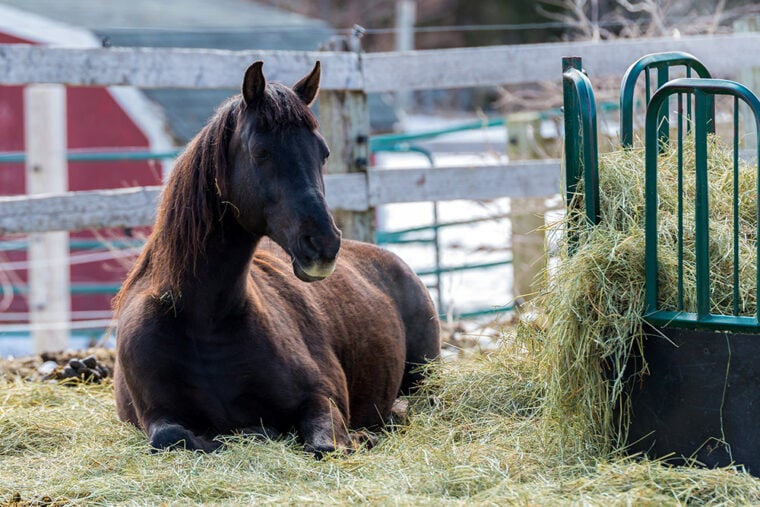
There are many reasons that you might need a new horse hay feeder. Whether you have recently started renovations where they generally get fed, you bought a new horse, or your old hay feeder was ruined, getting a new one as soon as possible is necessary. Instead of springing for a brand-new option right away, consider a DIY solution.
There are many options for DIY horse hay feeders. Often, it comes down to finding something that you can recycle or upcycle to suit your purposes. Or you can get crafty with wood and metal designs.
The 10 DIY Horse Hay Feeder Plans
1. Simple Trough Feeder

| Materials: | Plastic trough (x1), hay bag (x1), carabiners (x4), rope |
| Tools: | Drill |
| Complexity: | Basic |
This simple trough hay feeder is the perfect addition to any horse pasture. Using a hay bag and a durable trough, you can create a slow feeder that helps regulate your horse’s eating without breaking the bank. The hay bag keeps your horse from gorging itself on your expensive hay while keeping it safely contained in a durable container. This is a project almost anyone can do. All it takes is a few holes created with a drill and the necessary supplies. This project can be finished in just a few minutes.
2. Affordable V-Feeder
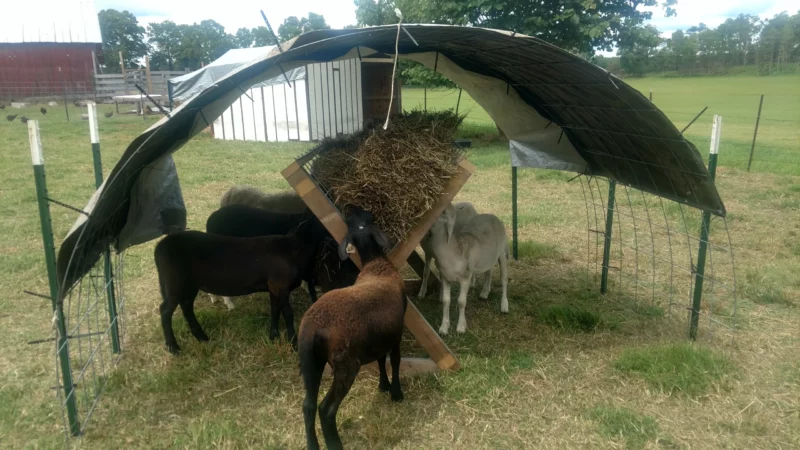
| Materials: | 2x6x8 (x4), stock panel (x1), nails |
| Tools: | Hammer, miter saw |
| Complexity: | Basic |
Some feeders get out of control in terms of complexity and price. If you just need a primary feeder to get your hay off of the ground or if you are tired of wrestling with hay bags, you should consider this affordable V-feeder. This simple design uses four pieces of lumber and a basic stock panel to create a cradle that can hold a decent amount of hay. You don’t need a ton of tools or supplies to build this hay feeder, and it can be completed by a single person in just an hour. It requires a few cuts and a few nails, and you’ll be off and running.
3. Clever Barrel Feeder
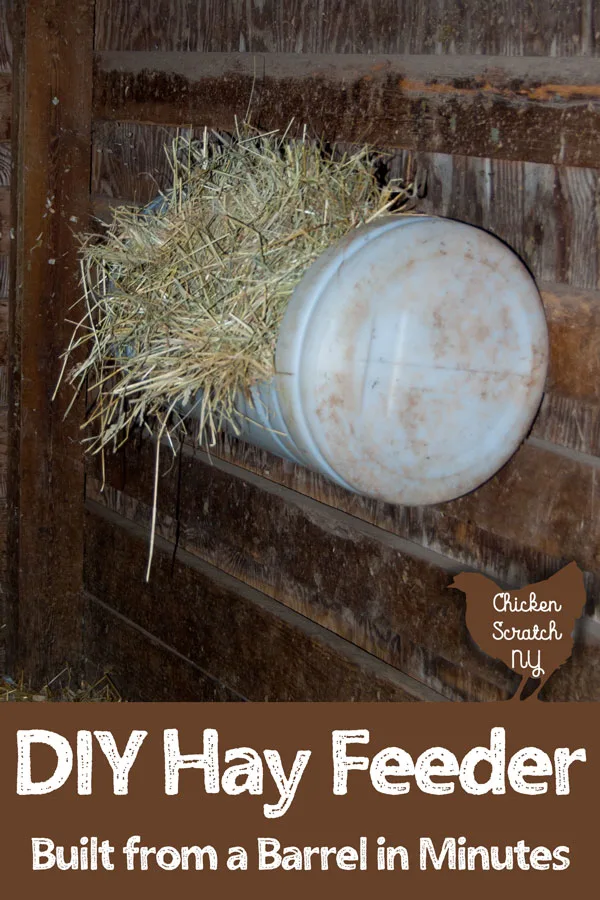
| Materials: | Plastic barrel. screws |
| Tools: | Jigsaw or circular saw, drill |
| Complexity: | Basic |
Many farms have plastic barrels lying around. Luckily, these barrels can be repurposed into a simple hay feeder that is easy to fill and will keep the hay off of the ground. This clever idea takes a plastic barrel and mounts it to the wall with a few holes in it for the hay to stick out of. You can cut whatever type of holes you want. You can make a very large opening for a flake of hay, or you can drill some smaller holes for a slower feeder. The choice is up to you. These barrels are light enough to easily be mounted to any wall with a couple of screws. Just make sure to keep it out of the sun because the plastic breaks down over time in direct sunlight.
4. Easy Round Bale Feeder

| Materials: | 16’ stock panel (x1-2), carabiners (x4-8), zip ties |
| Tools: | Angle grinder |
| Complexity: | Basic |
Round bale feeders can be very expensive, but they are often necessary. Horses will feast on a round bale with abandon if you let them, and the messy eats can trash a bale wasting tons of hay. You don’t need to shell out hundreds of dollars for a round bale feeder to protect your hay. You can build your own. These plans use some flexible stock panels and carabiners to create a protective barrier around your round bale. Just bend the panels around the bale and lock them into place with the carabiners. When you need to replace the bale, just undo the clasps and refill. You can also flatten this feeder and load it into a truck or even drag it away with a tow rope to move it. Very versatile!
5. Cute Wall Mount Feeder

| Materials: |
2x4x8 (x4), a sheet of plywood, 1×2 furring strips, small roll of garden fencing, wood screws
|
| Tools: | Circular saw, drill |
| Complexity: | Intermediate |
This wall mounted feeder is adorable and will look great in any barn. Using a handful of 2x4s and some furring strips, you can build this angled box and attach it to nearly any barn wall. There is room to modify this design to make it bigger if you have a large horse or multiple horses in an area. The original plans used leftover 1×18 hobby wood, but that is not common. You can also use your choice of plywood to create the sides. The garden fencing turns this into a very versatile slow feeder. It also helps that it looks pretty darn good. The same can’t be said of all hay feeders.
6. Old Wood Outdoor Feeder
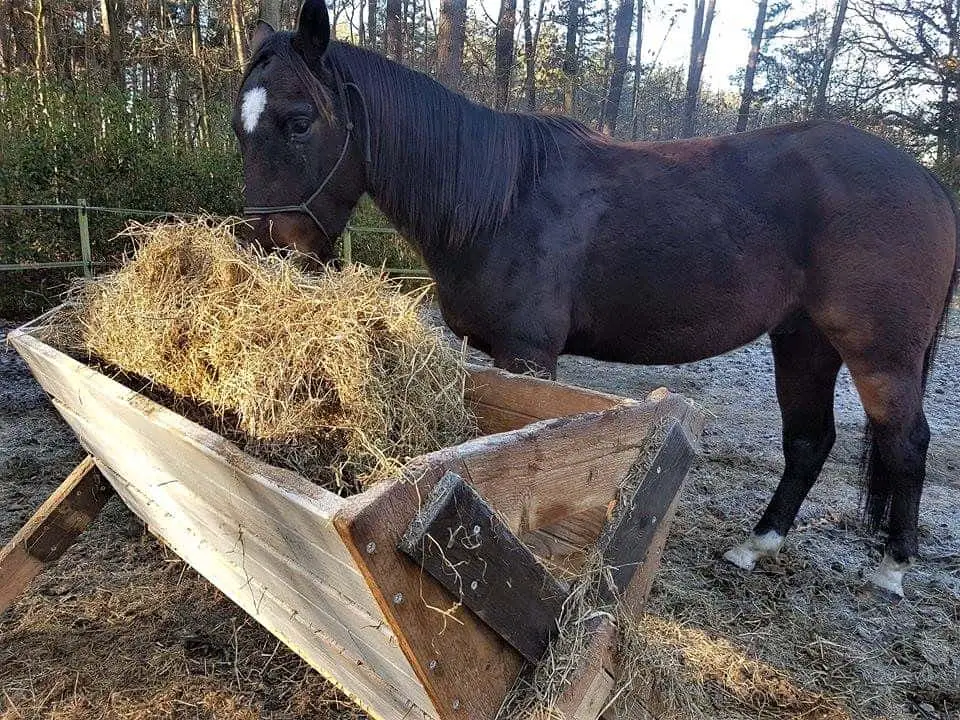
| Materials: | Scrap wood, pallet wood, barn wood, screws |
| Tools: | Miter saw, drill |
| Complexity: | Basic–Intermediate |
This project is perfect for someone who has a lot of leftover wood from another project or old barn wood. This modular design is very adjustable and uses old wood to create a simple V-feeder that is perfect for setting up outside. This is an enclosed feeder with an open top, so it is not a slow feeder, but it is great for people on a budget. Weathered wood is usually fine sitting outside, and it will keep your hay off the ground and out of the mud. Adjust these plans based on what kind of scrap wood you have and how many horses you are trying to feed.
7. Hay Feeder on Wheels

| Materials: | Rolling trash can |
| Tools: | Jigsaw, drill, and bit |
| Complexity: | Basic |
This feeder is not the best looking feeder around, but it is very versatile and easy to make. It uses an old (or new) rolling trash can to create a simple feeder that is easy to load and easy to move. Using a jigsaw, you can create one large hole at the bottom or numerous small circular holes around the body of the trash can. Just flip the lid open and dump your hay flakes when you are ready to reload. If you need to move the feeder, simply wheel it to a different location. It is incredibly simple. This is great for people who rotate pastures or like to load the hay feeders in the barn away from nosey horses.
8. Upcycled Hay Feeder
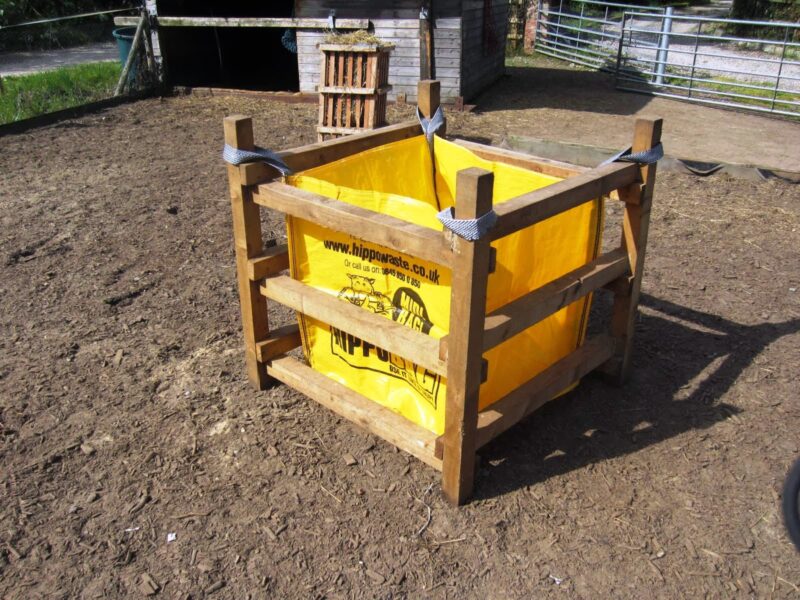
| Materials: | 4x4x8 (x2), 2x4x8 (x6), screws |
| Tools: | Drill, miter saw |
| Complexity: | Basic |
The creator of this idea got inspiration from the fact that there are numerous leftover materials to be found on construction sites. He is a contractor who found himself with some scrap wood and old empty 1-ton sandbags. The sandbags were a great way to hold hay. But this idea can be used for almost anything. Building a simple box, you can put an old hay bag or hay net in it. Or you can leave the center empty and just put hay straight into the box. If you don’t have old wood lying around, this project can still be easily completed for less than $100.
9. Corner Feeder for Barn
| Materials: | 2x6x8 T&G (x4), brad nails |
| Tools: | Brad nailer, miter saw |
| Complexity: | Basic |
The hardest part of completing this project is acquiring the tongue and groove boards. You can build this without tongue and groove, but the grooved boards add strength and allow you to easily lock them into the corner without much hassle. All you need to do is measure your corner, then cut the ends to length at a 45-degree angle. You might need to adjust the materials to fit your corner. You can lengthen the boards to create a bigger hay feeder for a larger horse. You can also add a hay bag or hay net over the top to turn it into a slow feeder as well. There are plenty of options to fit any suitable stall corner you might have.
10. Cheap Pallet Hay Feeder

| Materials: | Pallets (x4), 2x4x8 (x2), nails, wood screws |
| Tools: | Drill, hammer |
| Complexity: | Basic |
There is not much you can’t build out of pallets if you put your mind to it. This cheap pallet feeder can be built for very little money. If you have some pallets lying around and some leftover 2x4s, you can build this feeder for free. All you need to do is arrange the pallets and secure them together with some screws and nails and a bit of bracing. You can easily make multiple of these feeders or string a couple together to create a much bigger feeder. This is the perfect project for horse owners on a budget or people who have some extra pallets ready for use.
Slow Feeder vs Open Feeder
There are two types of hay feeders. There are slow feeders and fast (or open) feeders. Some horses need slow feeders to regulate their eating. It can be bad for a horse’s digestive system to continuously eat, and it can lead to dangerous impactions. Slow feeders use netting or holes to make it harder for the horse to eat the hay. Open feeders leave the hay exposed to open air and allow horses to eat as much as they want as fast as they want.
Older horses that have worn teeth and diminished appetites will likely do fine with a fast feeder. They are unable to eat as much or as quickly as younger horses. Young horses or large horses would likely benefit from a slow feeder. Slow feeders also help keep the mess and the hay waste down by making horses eat more deliberately. Hay waste is money waste, and it can make a huge mess, especially in small spaces.
There are both slow feeders and fast feeders on this list for you to choose from. So, pick the one that will best fit you and your horse.
Conclusion
There are some truly great options here for anyone looking to make a DIY hay feeder for a horse. Some of these projects can be completed in minutes, while others won’t cost more than a few dollars. Whether you are trying to reduce hay waste for multiple horses or are trying to keep your hay off the ground for one older horse, there are plenty of great projects here for you to choose from. Most of them are very basic and don’t take a contractor to complete them in a timely fashion.
See also:
Featured Image Credit: Doug McLean, Shutterstock








